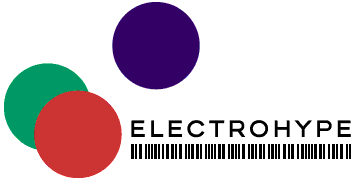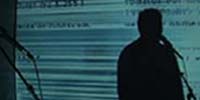 |
October
21st, 2002]

Electrohype 2002 - Interview with Lars Midbøe
The first ever Nordic Biennale for computerbased
art, Electrohype, takes place for the second time in Malmoe,
Sweden from the 23rd to 27th October 2002 showing both Nordic and
international artists. The first Electrohype exhibition took place
in 2000. This time, the exhibition is supplemented with the conference
'Art and Software - Software as Art'. Lars Midbøe
and Anne Kindvall are the two behind it all. During the busy
last days of preparation, Kristine Ploug from managed to
persuade Lars Midbøe to answer a couple of questions. Translated
by Stine Berger. Photos: Electrohype's press photos.
Electrohype - exhibition
Carolinahallen
Östergatan 7, Malmö
and
Malmö Konsthall
S:t Johannesgatan 7, Malmö, Sweden
Opening times: Wednesday 23rd Oktober to Sunday the 27th October
11am- 5 pm
Participating artists: Laura Beloff/Erich
Berger (Finland/Austria), Andrew C. Bulhak (Australia), Rikard Lundstedt
(Sweden), Ellen Røed (Norway), Oncotype/Subsilo/Dinsen/Christiansen
(Denmark), C. Anders Wallén (Sweden), John F. Simon, Jr.
(US), Marek Walczak/Martin Wattenberg (US), Magnus Wassborg (Sverige),
Thomas Broomé (Sweden), Helen Evans/Heiko Hansen (France),
Lisa Jevbratt (Sweden), Federico Muelas (Spain), Paul Smith/Vicky
Isley (UK), Gisle Frøysland (Norway), Victor Vina (UK)
'Art and Software - Software as Art'- conference booking
required
Filmstaden
Storgatan 22, Malmoe. Sweden
Speakers: Andreas Brøgger (Denmark) and John F. Simon, Jr.
(US),
Further information: www.electrohype.org
How did Electrohype start?
Electrohype happened as a reaction to the fact that neither Sweden
nor the Nordic countries as a whole had a forum for computer-based
art. Anna Kindvall was, at the time, working at the Digitala Bildverkstaden
in Malmö, where I was also a member and later worked there,
too. We met up and discussed the possibility of arranging an event
that could prove that good computer art does exist. Anna outlined
an idea, which we have since developed. As we started to get our
initial funding, it became necessary to create an organisation,
and since then we have attracted more support which has enabled
us to enlarge the scale of the project. Our original plan was to
make just one exhibition, but the response at Electrohype 2000 was
so overwhelmingly positive and we had lots of enquiries about when
we would hold our next event. Since then we arranged two commissioned
exhibitions (NIC 2001 in Copenhagen and Hotspot #3 Electrohype at
Gotland, Sweden) while at the same time working on making Electrohype
2002 a reality.And so now we are here. Our exhibition opens on Wednesday,
which means we have established the first ever Nordic Biennale for
computer-based art. Also, as you probably know, we have received
funding from 'Framtidens Kultur' (Future Culture, a Swedish funding
organisation-ed.) to establish The Electrohype Centre, a place that's
going to be a platform for our future activities. We will also attempt
to make a few smaller exhibitions and seminars, everything with
a focus on computer-based art and perhaps also artforms close to
the genre in order to put computer-based art into perspective.
What are your backgrounds?
Anna graduated from Malmö Art School and has plenty of experience
of using computers in her work. In 1997 she travelled to Holland
where she studied New Media at Groeningen. Since then she has produced
a great deal of interactive and web-based art. For more information
visit: http://www.algonet.se/~annak/.
My own background is in photography, and I started working with
computers in the beginning of the nineties. With photography I soon
discovered exciting possibilities, beyond the purely practical,
and I have since worked with computers in conjunction with both
sound as well as image and video. I have taught various digital
techniques and worked as a technician at several Swedish art schools.
But since 2000 I have primarily worked on Electrohype.
I sense from Copenhagen that Malmö has a really 'happening'
art scene, especially for digital art. For example last spring Lev
Manovich (www.manovich.net),
one of the most respected theorists did a talk, and now Electrohype
is running again for the second time…
Yes, Malmö has an exciting art scene especially at the grass-roots
level. There are a great variety of projects and groups that seem
to exist for anything from days through to months and beyond. Unfortunately
a lot of the projects disappear before they ever get established
properly. In Malmö quite a few people are interested in electronic
music, and there are several courses where students can work with
new media and technology which makes a good breeding ground for
the creation of new art. I also feel that the smaller groups operating
within a more flexible organisation are particularly successful
at promoting themselves across the Øresund Region. It is
easier to get in contact with like-minded people in Malmö/Copenhagen
who are part of small groups rather than larger, more formal institutions.
For example, we have worked with LAB - a collaboration that was
nice and simple to carry out, and I am aware that several other
people in Malmö have worked both with LAB as well as other
groups in Copenhagen.
Actually there's a bit of an amusing story to do with Lev Manovich.
We received an email from him, where he told us that he was coming
to Malmö, and that he would like to meet some of us from Electrohype.
And as with a lot of people, he was surprised to discover that Electrohype
is more or less just Anna and myself. A lot of people are under
the impression that it is a large organisation.
 
(l) Thomas Broomé (Sweden): HellHunt
(r) Magnus Wassborg (Sweden): FulHack
Electrohype 2002 consists of a conference discussing theory
as well as an exhibition. Is digital art more closely linked to
art theory than other artforms?
No, I don't reckon that computer-based art has a closer link to
art theory. If one looks back to the early nineties, it was very
popular to theorise about photography, and for that reason computer-based
art seems to have fallen in to that category of attracting theory
because it is also a comparatively new media for the art world.
Perhaps it also has something to do with the fact that a lot of
people, who are interested in literature and poetry have approached
the basic part of computer art: the programming. I know that there
are strong links between these fields in Germany and Russia. Or
it is probably natural that young theorists focus on this art form
that they have experience of from their own lives.
They have grown up with the Commodore 64 computer and computers
games and reckon that it is more interesting to work with computer
art theory rather than for example oil paintings or 18th century
architecture. There are quite a few parallels to Modernism that
are interesting to the theorists - one can see links to the enlightenment
and the optimism of the avant-garde.
How did you choose the participating artists?
We have our own way of choosing the art for our exhibitions. We
announce a 'Call for Entries', which allows artists to apply to
participate in the exhibition. At the same time we have a list of
artists and works that that we have seen or heard of, during the
time between exhibitions. This time around we received 250 applications
from 31 different countries. Anna and I make a preliminary sorting
and present it to a jury, and then we discuss what is good and less
good, and slowly but surely we come up with a selection. Then we
contact the artists we want to invite, and finally we have a selection
that works well as an exhibition. This way we include good works
from both the more established as well as less established artists.
We also have an objective to include a certain percentage of Nordic
artists in the exhibition to establish contact between the Nordic
and international artists.
As I mentioned our aim is to help promote computer-based art and
in relation to that it is important that the artists make connections.
What direction is Webart heading in? Have you detected any clear
movements?
With Webart in particular it is hard to define a direction.
I don't even think that there is yet a definition of what Netart
or Webart is. It is still being discussed in various forums.
Generally, if I was to point out a tendency, it would be that there
seems to be a preoccupation amongst the artists to visualise the
things that are actually happening on the internet. They are looking
at the internal processes happening between human and machine and
from machine to machine. Earlier on, a lot of people used the internet
to distribute traditional fine art, or art which strongly refers
to other traditions such as photography, film, and animation. Today
one can experience works that for example visualise the traffic
on a local network or installations that move the process out of
the computer, into physical space. In particular I am thinking about
the work of Lisa Jevbratts and Victor Vina.
 
(l) Lisa Jevbratt's (Sweden): Out of the
Ordinary. (r) Morten Schjødt, Peter Thillemann, Theis
Barenkopf Dinesen, Anne Dorthe Christiansen, Oncotype, Subsilo
(Denmark): Rekyl
Finally a bit about the definition of computer-based art. There
are a lot of different terms: Digital art, Web art, Multimedia art
etc. Electrohype works with the term 'computer-based' art.
As we were looking for works for our first exhibition we quickly
discovered that it was necessary to set up a framework, as a tool
for ourselves. The decision was to focus exclusively on works that
need a computer to function and not works that can be translated
into traditional linear mediums, for example animation that can
be transferred onto videotape. Some people think that we are too
dogmatic, but we reckon that there are already a lot of platforms
supporting, for example, video art, and for that reason we wanted
to put our energy into an area that we think needs a platform.
Today computers are everywhere, from home-PCs to mobile phones and
microwaves. It could be hilarious to see an installation that is
based on the computer in a Volvo
More…
www.electrohype.org
A report from the
performance by Artificial Paradises at LAB in November 2001,
arrangered, among others, by Electrohype. AP was performed on Friday
nights during Electrohype 2002.
|
 |
|